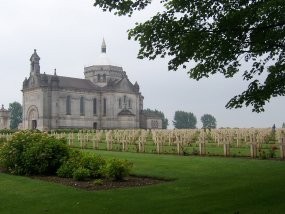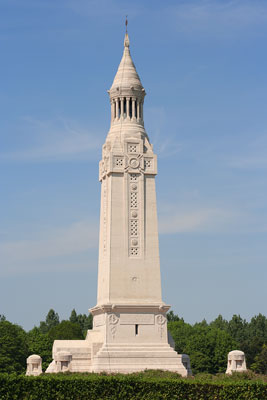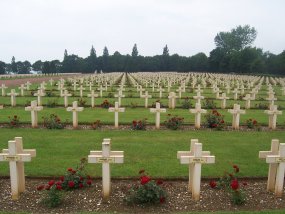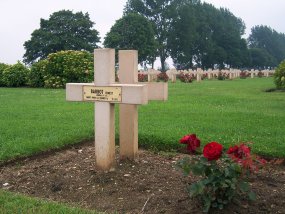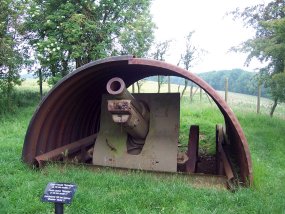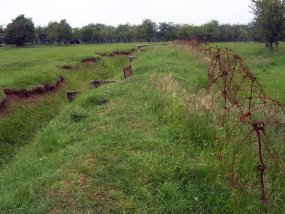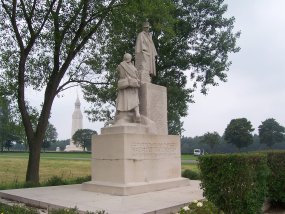
WWII: Maginot Line | Normandy | V-Weapon Sites | Arnhem
Further afield: Crete
| Home Tracing Military Ancestors Travel Advice CWGC Cemeteries Iron Harvest News Book Reviews Glossary Links Contact Me Artois:
 
|
Location 1 – Notre Dame de Lorette
Directions – Coming from the main Calais to Paris autoroute (A26) take junction 6.1 signposted to Aix-Noulette and join the D937 driving south. Pass through the village and a few kilometres further, on the right, is a signpost to Notre Dame Lorette. The French National Cemetery is at the top of the feature on the right. Park next to the cemetery entrance. Practical Information – Notre Dame de Lorette encompasses a number of sights for the visitor and you should allow a good hour and a half if you want to get the most from this location. For those staying for a long weekend, this is a good first stop for the mid to late afternoon, prior to checking into your hotel in the Arras area. Most British and Canadian tourists usually head straight for Vimy Ridge, so this location should be fairly unpopulated. Please also remember that this is one of France’s major places of national mourning and armed forces veterans and sometimes modern-day military forces are employed to ensure that the appropriate level of decorum is maintained. A restaurant and toilets are located at the rear of the site. French National Cemetery, Basilica, Lighthouse and Ossuary – The bald statistics of this cemetery, a symbol of national mourning, are quite staggering – covering 26 acres on the crest of Notre Dame de Lorette, there are nearly 20,000 named graves stretching as far as the eye can see. A further 20,000 lie unidentified in the two huge ossuaries to the right of the lighthouse tower. The very first grave on the left as you enter the cemetery is that of General Barbot, the commander of 77th Division and widely acclaimed as the saviour of Arras during the First Battle of Artois, killed on 10th May 1915 outside Souchez. The Basilica, built to replace the Chapel destroyed during the fighting was consecrated in the presence of Marshal Pétain in May 1927. The lighthouse tower was opened in August 1925 and stands 205 ft high. In the crypt are French unknown soldiers from the Second World War, the 1950’s and 60’s conflicts in North Africa and the ashes of concentration camp victims. The top of the lighthouse can be accessed by a flight of stairs to the right of the entrance. Notre Dame de Lorette Museum – Located at the rear of the site to the left of the restaurant. For details of this excellent museum see the museums page. Notre Dame de Lorette recreated battlefield – To the right of the museum and accessed by a turnstile using tokens purchased next door, is a recreated portion of the Notre Dame de Lorette battlefield complete with guns, barbed wire, trenches and defensive structures. Memorial to General Maistre – In front of the main cemetery entrance, this memorial pays tribute to the commander of the XXI Corps and his men who fought to capture Notre Dame de Lorette from December 1914 to May 1915.
Historical Notes – Whilst not as well known as Vimy Ridge on this side of the Channel, Notre Dame de Lorette was no less a place of horror and sacrifice during the first two years of the First World War. As you will notice as you travel through this sector, it completely dominates the ground to the north, east and south and, together with Vimy Ridge, formed the lynchpin of the German defences. Stretching from west to east, the feature is actually made up of a series of five spurs – Mathius, Grand, Arabes, Blanche Voie (the “Spur of the White Way”) and Souchez. Quickly grasping the importance of taking this feature as a pre-cursor to capturing Vimy Ridge to the south-east, the French XXI Corps under General Maistre launched a number of attacks on Notre Dame de Lorette between December 1914 and April 1915 and succeeded in taking three of the spurs up to and including Arabes spur. However, the Germans had also realised the importance of the feature and dug five trench lines packed with machine guns and protected by barbed wire and sandbags filled with cement between the Arabes spur and the Souchez spur. A major fortified zone near the Lorette Chapel at the highest point on the hill comprising casemates, palisades, redoubts and deep shelters to protect the garrison, supported these works. During the Second Battle of Artois three regiments of infantry and three battalions of chasseurs of the XXI Corps assaulted this formidable position. Going over the top at 10.00am on 9th May 1915, the élan of their attack carried three of the defence lines in the first two hours but broke down in front of Lorette Chapel. Against this strongpoint the French could make no progress and as the day wore on casualties mounted as the well dug in German infantry poured a murderous fire into the attacking units. For the next two days the French infantry desperately tried to find a way into the fortified zone until, eventually, on the night of the 12th the Chasseurs managed to get close enough to suppress some of the machine gun positions long enough for supporting infantry to get over the parapet. Once inside the battle broke down into a series of grim hand-to-hand combats involving bayonet, bullet and grenade – all the more terrifying in that it was fought in complete darkness. As the night wore on, however, the French gained the upper hand and, by dawn, were in possession of the crest of Notre Dame de Lorette. Elsewhere on the ridge the German defenders clung on as thick mud, the product of heavy rain slowed the French advance. It was another ten days before their positions on the southern reaches of the Blanche Voie and Souchez spurs were carried. Speaking after the battle of the XXI Corps, General d’Urbal of the 10th Army said, “Under the command of General Maistre, gave proof of a tenacity and devotion above all praise, in the course of repeated attacks carried out during several consecutive weeks, under intense bombardment, day and night, by the enemy’s artillery”*1. The XXI Corps had certainly done that, but they had also left behind thousands of dead on the slopes of Notre Dame de Lorette. The Association of Notre Dame de Lorette was founded in 1920 to create a cemetery and place of worship dedicated to the memory of the fallen. Eyewitness Account – One of the soldiers at Notre Dame de Lorette described the scene: "It is hot, and the smell is atrocious. The dead of the previous months, with only the thinnest covering of earth over them, have been torn from their graves by the shells. The plateau is a charnel-house..." *2 Accreditations – *1 and *2 Extracts taken from Illustrated Michelin Guides to the Battle-Fields (1914-1918) Arras Lens – Douai and the Battles of Artois by Michelin & CIE, G H Smith & Son, Easingwold, York 1994. |
||||||

